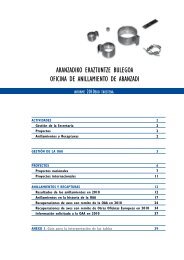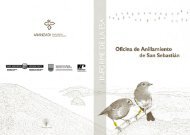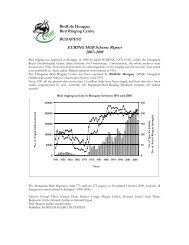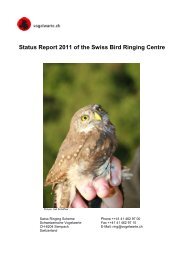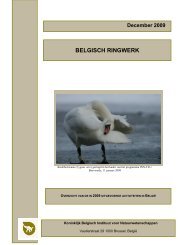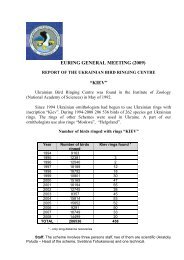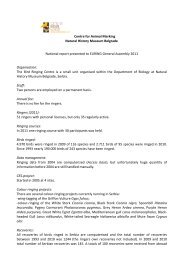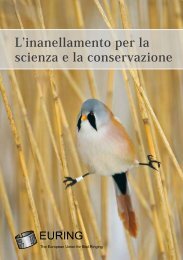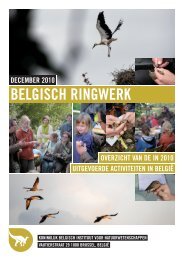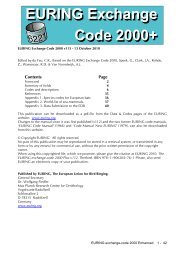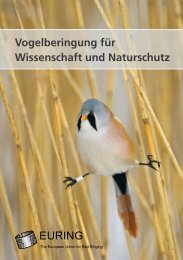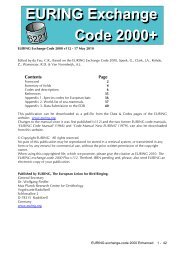The quantitative study of marked individuals in ecology, evolution ...
The quantitative study of marked individuals in ecology, evolution ...
The quantitative study of marked individuals in ecology, evolution ...
You also want an ePaper? Increase the reach of your titles
YUMPU automatically turns print PDFs into web optimized ePapers that Google loves.
EURING 2003 Radolfzell<br />
We found two breed<strong>in</strong>g strategies which have the same fitness, characterized by the<br />
number <strong>of</strong> years without reproduction (2 or 3) and the number <strong>of</strong> clutches with<strong>in</strong> reproductive<br />
years. However, such strategies are not fixed for a given female.<br />
10:45 AM - 11:05 AM<br />
Modell<strong>in</strong>g senility and dispersal <strong>of</strong> Red deer<br />
Ted Catchpole, T.N. Coulson, Y. Fan, & B.J.T. Morgan<br />
Red deer (Cervus elaphus) on the island <strong>of</strong> Rum have been closely studied for many<br />
years. In particular, this has resulted <strong>in</strong> an extensive mark-recapture-recovery (mrr)<br />
data set. Models for these data need an elaborate age-structure for survival, because<br />
deer react differently to environmental factors at different stages <strong>of</strong> their lives. An additional<br />
<strong>in</strong>terest<strong>in</strong>g feature <strong>of</strong> the data is that animals may leave the <strong>study</strong> area. Thus<br />
we are <strong>in</strong>terested not only <strong>in</strong> modell<strong>in</strong>g deer survival, but also deer dispersal. Our<br />
model<strong>in</strong>g approach is a classical statistical one. <strong>The</strong> two sexes need to be considered<br />
separately. With<strong>in</strong> each sex, we use standard likelihood tools and <strong>in</strong>formation criteria<br />
to identify age-classes, separately for survival and dispersal. With<strong>in</strong> each age-class,<br />
the relevant probability does not vary over the ages desribed by that class, with the<br />
exception <strong>of</strong> the oldest age-class for survival. This then allows us to undertake logistic<br />
regressions <strong>of</strong> the relevant age-class probabilities on a mixture <strong>of</strong> environmental and<br />
<strong>in</strong>dividual covariates. Senility, a gradual decl<strong>in</strong>e <strong>in</strong> survival probability with age, is described<br />
by means <strong>of</strong> a logistic regression on age with<strong>in</strong> the oldest survival ageclasses<br />
for males and females. <strong>The</strong> f<strong>in</strong>al models that we select for males and for females<br />
have an attractive simplicity. <strong>The</strong>y demostrate clearly the differences that exist<br />
between males and females, and may be used for predict<strong>in</strong>g future behaviour, and<br />
the effects <strong>of</strong> alternative management policies.<br />
<strong>The</strong> work <strong>of</strong> this paper is a natural extension <strong>of</strong> the models and model-selection<br />
procedures that have been developed for Soay sheep (Ovis aries) <strong>in</strong> Catchpole et al<br />
(2000) and Coulson et al (2001). <strong>The</strong> present work builds on the modell<strong>in</strong>g <strong>of</strong> male<br />
red-deer alone by Catchpole et al (2002), and the modell<strong>in</strong>g <strong>of</strong> both sexes <strong>in</strong> Fan et al<br />
(2002).<br />
11:05-11:25 AM<br />
Assess<strong>in</strong>g senescence patterns <strong>in</strong> populations <strong>of</strong> large mammals<br />
Jean-Michel Gaillard & Anne Viallefont<br />
<strong>The</strong>oretical models such as Gompertz and Weibull models are commonly used to<br />
<strong>study</strong> senescence <strong>in</strong> survival for humans (Olshansky & Carnes 1997) and laboratory<br />
or captive animals (Ricklefs 2000) for which a complete follow up <strong>of</strong> <strong><strong>in</strong>dividuals</strong> is<br />
available. For wild populations <strong>of</strong> vertebrates, senescence <strong>in</strong> survival has more commonly<br />
been assessed by fitt<strong>in</strong>g simple l<strong>in</strong>ear or quadratic relationships between survival<br />
and age (e. g., McDonald et al. 1996, Newton and Rothery 1997, Nichols et al.<br />
1997, Loison et al. 1999). By us<strong>in</strong>g appropriate constra<strong>in</strong>ts on survival parameters <strong>in</strong><br />
Capture-Mark-Recapture (CMR) models, we propose a first analysis <strong>of</strong> the suitability<br />
<strong>of</strong> Gompertz and Weibull models for describ<strong>in</strong>g ag<strong>in</strong>g-related mortality <strong>in</strong> free-rang<strong>in</strong>g<br />
populations <strong>of</strong> ungulates. We first show how to handle Gompertz and Weibull models<br />
<strong>in</strong> the context <strong>of</strong> CMR analyses. <strong>The</strong>n we perform a comparative analysis <strong>of</strong> senescence<br />
patterns <strong>in</strong> both sexes <strong>of</strong> two ungulate species highly contrasted accord<strong>in</strong>g<br />
to the <strong>in</strong>tensity <strong>of</strong> sexual selection. Evolutionary implications <strong>of</strong> our results are<br />
discussed.<br />
9



